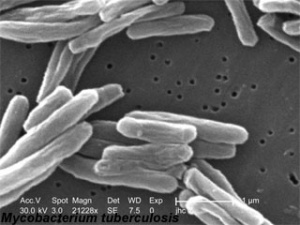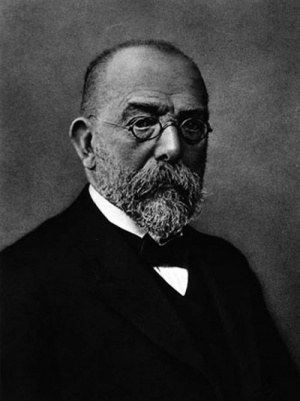Abnormal Development - Tuberculosis: Difference between revisions
No edit summary |
|||
| Line 63: | Line 63: | ||
<pubmed>20517736</pubmed> | <pubmed>20517736</pubmed> | ||
<pubmed>18301825</pubmed> | |||
<pubmed>17293929</pubmed> | |||
<pubmed>15772585</pubmed> | |||
<pubmed>14684547</pubmed> | |||
<pubmed>12571760</pubmed> | |||
===Search Pubmed=== | ===Search Pubmed=== | ||
Revision as of 07:02, 6 November 2011
| Educational Use Only - Embryology is an educational resource for learning concepts in embryological development, no clinical information is provided and content should not be used for any other purpose. |
Introduction
The gram-positive bacterium Mycobacterium tuberculosis causes the disease Tuberculosis (TB) usually initially infecting the lungs. The infection can cross the placenta to infect the fetus infecting many different systems (liver, bones, kidneys, spleen, gastrointestinal tract, skin, lymph nodes).
More than two billion people, one third of the world's total population, are infected with TB bacilli, an airborne infectious disease that is preventable and curable. Congenital tuberculosis cases are rare with a relatively high mortality rate.[1].
The Bacillus Calmette-Guérin (BCG) vaccine was first used in 1921 as a vaccine for tuberculosis disease and also used in some countries to prevent childhood tuberculous meningitis and miliary disease.
| Bacterial Links: bacterial infection | syphilis | gonorrhea | tuberculosis | listeria | salmonella | TORCH | Environmental | Category:Bacteria |
Some Recent Findings
Global Tuberculosis (new cases 2007)
Drug-Resistant Tuberculosis
Extensively drug-resistant tuberculosis (XDR-TB2) is a highly drug-resistant strain subset of multidrug-resistant TB (MDR-TB) that have significantly worse outcomes, has now been reported in more than 50 countries. (WHO data)
Multidrug-resistant tuberculosis (MDR-TB) is defined as resistance to the two most powerful first-line anti-TB drugs (isoniazid and rifampicin).
Extensively drug-resistant tuberculosis (XDR-TB2) is defined as MDR-TB plus resistance to the most powerful second-line anti-TB drugs (any fluoroquinolone and any of the three injectable drugs: amikacin, capreomycin and kanamycin).
Australian Recommendations
BCG vaccination is not recommended for general use in the Australian population.
BCG is recommended for:
- Aboriginal neonates in areas of high incidence of TB (e.g. Northern Territory, Far North Queensland, northern areas of Western Australia and South Australia).
- neonates and children 5 years and under who will be travelling or living in countries or areas with a high prevalence of TB for extended periods.
- neonates born to parents with leprosy or a family history of leprosy.
In addition to these recommendations BCG may be considered in the following:
- Children over 5 years who will be travelling or living in countries or areas with a high prevalence of TB for extended periods.
- Health care workers (HCWs) who may be at high risk of exposure to drug resistant cases.
(Text Source: Communicable Diseases Intelligence Volume 30 Number 1, March 2006 - The BCG vaccine: information and recommendations for use in Australia)
References
Reviews
<pubmed>21798463</pubmed> 21682802
Articles
<pubmed>20517736</pubmed> <pubmed>18301825</pubmed> <pubmed>17293929</pubmed> <pubmed>15772585</pubmed> <pubmed>14684547</pubmed> <pubmed>12571760</pubmed>
Search Pubmed
Search NCBI Bookshelf: Medical Microbiology - Tuberculosis Search
Search PubMed: Mycobacterium Tuberculosis
External Links
External Links Notice - The dynamic nature of the internet may mean that some of these listed links may no longer function. If the link no longer works search the web with the link text or name. Links to any external commercial sites are provided for information purposes only and should never be considered an endorsement. UNSW Embryology is provided as an educational resource with no clinical information or commercial affiliation.


